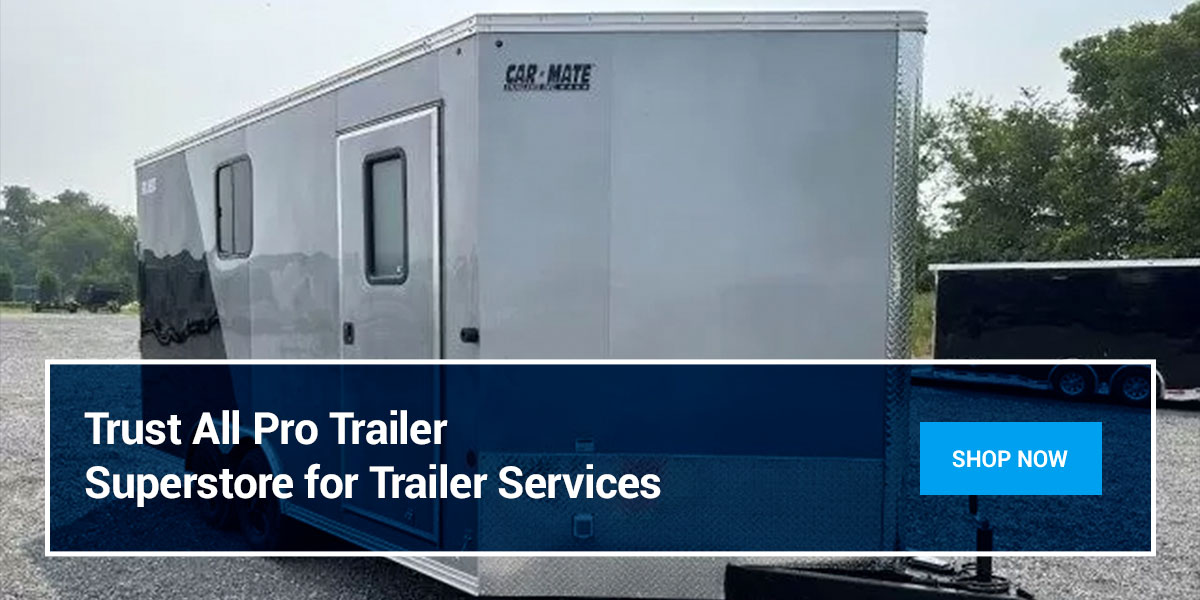How to Back Up a Trailer: Your Step-by-Step Guide
Jun 11, 2024Last Updated on June 11, 2024 by Daniel Houck
Last Updated on June 11, 2024 by allprotrailersuperstore

Reversing a trailer for the first time can seem challenging. This process is different than simply reversing a vehicle or backing up a car with an attachment in the rear.
Several elements can impact the process, and learning to exercise the right control and speed can take some time. Thankfully, with enough practice, the right tips and an ample amount of driving space, you can learn how to reverse a dolly trailer safely.
Pre-Reversal Checklist
Proper trailer reversal starts before you ever move the vehicle. You must follow several vital steps to prepare your vehicle and yourself before moving in any direction:
- Install the trailer hitch: Select the right trailer hitch for your vehicle and trailer, and ensure proper hitch installation before attempting to move the vehicle. This process involves removing and reinstalling several vehicle components, and each piece must be secure. Having someone assist you with this can be beneficial to ensure precision.
- Ensure the area behind the trailer is clear: As you would when backing up any vehicle, checking that the area behind the trailer is clear ensures the safety of any person or object in the area. For your first couple of times practicing, you should have a few extra feet of space around the vehicle, even if you don’t intend to need it. This extra precaution can ensure safety and ease stress related to fitting in a tight space.
- Adjust your mirrors for optimal visibility: Vision is essential during the reversal process. You will need a clear view of your surroundings, which means adjusting your mirrors to get the best backward view possible. Always adjust your mirrors when the vehicle is stationary.
- Engage the vehicle in the correct gear for reversing: Your last step before moving the vehicle is to ensure it’s in the appropriate gear for reversing. The last thing you want to do is lurch to a start and stop because you forget to change gears.
Double-check every item on this preparation list, and get ready to move.
How to Reverse a Trailer
Once you’ve completed the pre-reversal steps, it’s time to start moving. Take your time following the steps below, and remember that you may need to try multiple times before you get the hang of the process. If you feel the need to restart, safely check your surroundings and revisit step one until you feel comfortable.
1. Positioning the Vehicle
Spend some time learning how your trailer responds to vehicle movements. When reversing, the trailer will seem to move in the opposite direction than you intended. If you have a heavy or wide load, you may need to spend additional time determining the appropriate speed and angle for a safe reversal. If you anticipate making a wide turn, be sure to give yourself ample space.
This process is often easiest when you place your hand at the six o’clock position on the steering wheel. You can use this to visualize the way you will steer. For example, moving your hand left will move the trailer left, while moving your hand right will move the trailer right.
2. Reversing the Trailer
For the most straightforward reversal process, back up the trailer in a straight line whenever possible. If you need to turn while reversing, opt for a right turn. Reversing to the right will allow you to see the rear corner of the trailer through your mirror or out the window. This can make it easier to navigate tight spots or reverse when hauling heavy equipment, caravans, boats and similar large objects.
If you need help remembering which way to turn, you can rely on the steering wheel to find the proper position, as noted in step one.
3. Using Your Mirrors
Although your mirrors will aid in the reversal process, especially if you cannot see over or around the trailer, you will want to rely on your eyes whenever possible. The rearview mirror can make the process seem more confusing when everything is occurring in reverse, so rolling down your window and looking over your shoulder might be the most efficient way to move.
Tow mirrors can extend your side mirror views, making them a great tool if you plan to haul your trailer repeatedly. If you don’t have someone sitting in the passenger seat, you will likely need to use your left mirror at some point, but don’t forget that you can always stop and step out of the vehicle to monitor your progress if necessary.
4. Controlling Your Speed
Moving slowly and making minor adjustments is the safest and most efficient way to reverse a trailer. Making major adjustments can be challenging and lead to jackknifing. Maintaining a slow and steady speed will make it easy to identify if you’re veering off course and allow you to readjust early so you encounter fewer problems down the line.
Common Mistakes to Avoid During the Process
Recognizing common mistakes in the reversal process can be just as helpful in learning as understanding the proper steps to take. Check out these common mistakes and how to avoid them:
- Oversteering: Moving too quickly in a tight spot or around a corner, braking suddenly and aggressive acceleration can cause oversteering. Always move slowly, and be sure to have enough operating space before reversing.
- Losing sight of the trailer in mirrors: Vision is essential for reversing a trailer. If you ever lose sight of the trailer, you will have no idea whether you’re moving where you want to or if a person or object is obstructing your movement. Always adjust your mirrors before moving the vehicle.
Safety Tips When Learning How to Reverse a Trailer
Safety should always be at the forefront of your mind. As a first-time tower, there are a few things to know before getting on the road. These tips can help protect your vehicle, trailer and the object you’re towing from damage:
- Use a spotter: In some cases, you may be unable to see around or over the trailer. In these circumstances, having a spotter is essential. Your spotter should use visual and audible cues to prompt your movements.
- Know what to do if you jackknife: You can often avoid jackknifing by moving slowly, but if you encounter this situation, you should know how to handle it. Take your foot off the pedals, focus on your steering and steer in the direction of the skid. Make this adjustment slowly, as a rapid adjustment in the direction of the skid could overcompensate and make the situation worse.
- Reassess if something seems wrong: If, at any point, something seems wrong, park your vehicle and identify the problem. Whether you have a poor hitch installation, need to recenter the vehicle multiple times or perform another corrective action, be sure to do so.
Trust All Pro Trailer Superstore for Trailer Services
At All Pro Trailer Superstore, you can find high-quality trailer services, including customization, financing, delivery, repairs and inspections, and more. As the top full-service trailer provider in the nation, we understand how to help you find the best trailer to fit your needs and essential services to extend its lifetime and ensure its integrity. Our team is always ready to help, so reach out with any questions you have.




